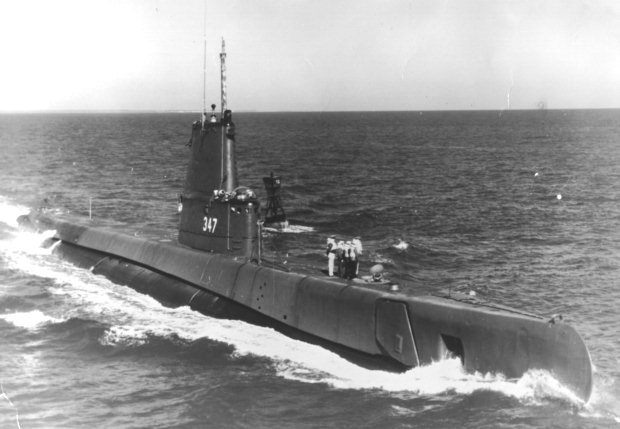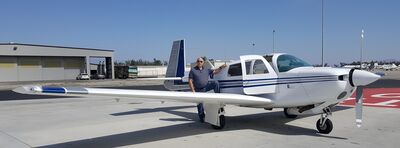"It came from Beneath the Sea"
Mar 31, 2024 08:49:12 #
I watched this 1955 film last night, "It came from Beneath the Sea." It was a about a nuclear submarine that encountered a giant squid that was affected by radiation from nuclear bombs tests. I thought the sub was odd-looking, so I Googled the number - 347. SS 347 was the Cubera, named after the fish, launched in 1945. It was powered by four GM V16 diesel engines, not atoms. I wonder if those were old Cadillac V16s converted to diesel. Probably not. 😋
You have to admit, it does have a distinctive look. I've never seen a conning tower like that.
You have to admit, it does have a distinctive look. I've never seen a conning tower like that.

Mar 31, 2024 09:57:35 #
StanMac
Loc: Tennessee
The bow looks like a canoe. Quite different from modern designs for sure.
Stan
Stan
Mar 31, 2024 10:09:27 #
Post WW II but pre-nuclear?
Interesting story about submarine design. Right after the war, Charles "Swede" Momsen (famous for developing the Momsen lung) was asked to figure out a way to increase the speed of submarines moving underwater. He threw out conventional surface ship design philosophy and looked at nature, specifically the Tuna as having the least water resistance. His prototype was, (wait for it) the Albacore. Naturally, naval leaders were skeptical until he challenged the navy to a race. Not only did the Albacore "swim circles" around older subs, it outran the fastest destroyer; something considered impossible. The rest is history as all nuclear subs use Momsen's "tuna"design.
Interesting story about submarine design. Right after the war, Charles "Swede" Momsen (famous for developing the Momsen lung) was asked to figure out a way to increase the speed of submarines moving underwater. He threw out conventional surface ship design philosophy and looked at nature, specifically the Tuna as having the least water resistance. His prototype was, (wait for it) the Albacore. Naturally, naval leaders were skeptical until he challenged the navy to a race. Not only did the Albacore "swim circles" around older subs, it outran the fastest destroyer; something considered impossible. The rest is history as all nuclear subs use Momsen's "tuna"design.
Mar 31, 2024 10:36:38 #
Mar 31, 2024 10:47:48 #
Mar 31, 2024 12:25:52 #
fourlocks wrote:
Post WW II but pre-nuclear? br br Interesting s... (show quote)
Smart engineer. Always look to nature first. Several million years of evolution will probably give us a good basis for the optimum design.
Mar 31, 2024 12:27:51 #
TheShoe
Loc: Lacey, WA
StanMac wrote:
The bow looks like a canoe. Quite different from modern designs for sure.
Stan
Stan
Looks like a relative of the Nautilus.
Mar 31, 2024 12:43:46 #
TheShoe
Loc: Lacey, WA
fourlocks wrote:
Post WW II but pre-nuclear? br br Interesting s... (show quote)
Nautilus predated the tuna design. Seawolf was a variant of the Nautilus. IIRC, there was one shaped like a blimp before the tuna took over.
Mar 31, 2024 12:55:17 #
lbrande wrote:
Smart engineer. Always look to nature first. Several million years of evolution will probably give us a good basis for the optimum design.
That's why planes now have those little winglets.
Mar 31, 2024 13:23:50 #
Standard sub design back then and the engines that produced the electricity for the batteries and drove the sub when on the surface were mostly Fairbanks Morse = https://en.wikipedia.org/wiki/Fairbanks_Morse_38_8-1/8_diesel_engine#:~:text=38%208%2D1%2F8%20diesel%20engine.,War%20II%20and%20the%201950s.
Packard made Merlins were used in PT boats etc. The early designs used Allisons but then the Merlins took over mostly. Those Packard made Merlins were a US modified design. Redesigned for mass production assembly lines and easier upkeep. Even many UK ground crews tried to get hold of them when doing an engine replacement because the US parts were "drop in" while the UK made engines needed a "fitter" to re-machine parts for repairs.
My Mom and Dad met at Packard in Detroit where they made the Packard Merlins. He was foreman of the wiring inspection department on one shift and she was his head inspector.
So I have fond thoughts for the Packard made Merlins, they were one of the main reasons I am here.
Packard made Merlins were used in PT boats etc. The early designs used Allisons but then the Merlins took over mostly. Those Packard made Merlins were a US modified design. Redesigned for mass production assembly lines and easier upkeep. Even many UK ground crews tried to get hold of them when doing an engine replacement because the US parts were "drop in" while the UK made engines needed a "fitter" to re-machine parts for repairs.
My Mom and Dad met at Packard in Detroit where they made the Packard Merlins. He was foreman of the wiring inspection department on one shift and she was his head inspector.
So I have fond thoughts for the Packard made Merlins, they were one of the main reasons I am here.
Mar 31, 2024 13:34:02 #
fourlocks wrote:
Post WW II but pre-nuclear? br br Interesting s... (show quote)
Yes, they still made diesel-electric boats after the war. Most navies still use diesel-electric subs. Underwater, they are the quietest subs in the world when running on batteries. In fact, good passive sonar operators can find them by looking for a "hole in the water" instead of the sounds they make.
Mar 31, 2024 13:39:20 #
The old subs used surface ship type hulls because they actually ran on the surface when trying to get anywhere in a hurry. Run fast and charge batteries at the same time. Underwater they have to snorkel to charge batteries and they are both noisy and slow while doing that. If nothing else, the snorkel is easy to spot when they are moving. You see a small bow wave with a pipe sticking up out of it. If they aren't moving while snorkeling, then you have a sound source sitting still.
Mar 31, 2024 13:47:07 #
jerryc41 wrote:
I watched this 1955 film last night, "It came... (show quote)
Not V16 gas engines converted.
The Detroit (gm) 16v a two cycle diesel came different sizes and were actually two 8v's connected in line, Two sizes I know of were the 71 cu.in per cyl and the 110 cu.in per cyl ., the HP, was governed by which injectors were used.
Mar 31, 2024 21:29:51 #
therwol
Loc: USA
lbrande wrote:
Smart engineer. Always look to nature first. Several million years of evolution will probably give us a good basis for the optimum design.
Isn't it interesting that modern airplanes have wings and a tail? Just saying.
Apr 1, 2024 08:15:49 #
robertjerl wrote:
Standard sub design back then and the engines that... (show quote)
Your last two paragraphs really add interest to your post.
Your info is quite interesting too.
If you want to reply, then register here. Registration is free and your account is created instantly, so you can post right away.





